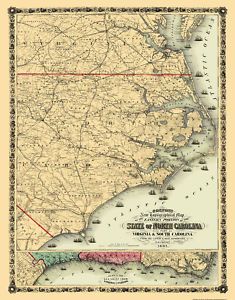 Loyalties are not always clearcut in North Carolina. Although the state has contributed more soldiers to the Confederacy’s cause then any of her neighboring states, Union sentiment in the Tar Heel State is robust enough that eight Union regiments are ultimately formed from the state’s citizenry.
Loyalties are not always clearcut in North Carolina. Although the state has contributed more soldiers to the Confederacy’s cause then any of her neighboring states, Union sentiment in the Tar Heel State is robust enough that eight Union regiments are ultimately formed from the state’s citizenry.
Skirmishes between Confederate and Union loyalties have been ongoing since the beginning of the war. Now, the growing number of freed slaves has led to the formation of three colored North Carolina Union regiments–the First, Second, and Third North Carolina Colored Infantry regiments. A fourth colored regiment, the First North Carolina Colored Heavy Artillery, will be recruited two months hence. Altogether, some 5,034 black men serve in these four regiments in the course of the war. Many, perhaps most, are Baptists.
Since August 29, 1861 the United States has occupied North Carolina’s Hatteras Island, while Roanoke Island has been occupied since early 1862. The Union’s continued control of the islands and the state’s coastal waters at large is testimony to the strength of the Union Navy as well as the lack of an effective Confederate naval presence.
Early 1862 witnessed the beginning of a mass movement of escaped slaves to Roanoke Island. In June 1863, the United States began organizing the First North Carolina Colored Infantry, and in the months following two additional regiments were formed.
Brigadier General Edward A. Wild is now in command of all area colored regiments. Headquartered in Norfolk, Virginia, he is keen on freeing more slaves from eastern North Carolina, many of whom he hopes to recruit as soldiers.
This month General Wild invades eastern North Carolina with portions of the First and Fifth United States Colored Regiment, the 55th Massachusetts Colored Regiment, and the First and Second North Carolina Colored Regiments. Marching into Elizabeth City largely unopposed, the federals stay for seven days while recruiting soldiers and acquiring supplies. When guerrillas attack the soldiers as they are leaving town, Wild executes one captured offender and takes as hostages the families of some others.
The federals continue recruiting and raiding in the North Carolina countryside throughout the month, returning to Norfolk with some 2,500 former slaves. Altogether seven of Wild’s men are killed, nine wounded, and two taken captive.
Of his black soldiers, Wild heartily commends their bravery, endurance and fighting skills, declaring that they are “the most reliable of soldiers.”
The raids leave many white eastern North Carolinians enraged. At the same time, however, they serve as a local indicator of the decided direction of the larger war effort. The United States, in short, is increasingly arming willing Southerners, both black and white, in the war against the Confederacy. These efforts will only grow in scope and intensity in the months to come. And of the black former-slaves-turned-soldiers, a large percentage are Baptists who by their actions demonstrate the delusional thinking of many white contributors to the states Baptist publication, the Biblical Recorder, who continue to insist that blacks, incapable of advanced intelligence and too timid to serve as soldiers, are content and happy in an enslaved state.
Sources: “The Forgotten Sons: North Carolinians in the Union Army,” Glenda Hicks, Thesis, Appalachian State University, 1968 (link); James Bryant, The 36th Infantry United States Colored Troops in the Civil War: A History and Roster, McFarland, 2012 (link) and review (link)


